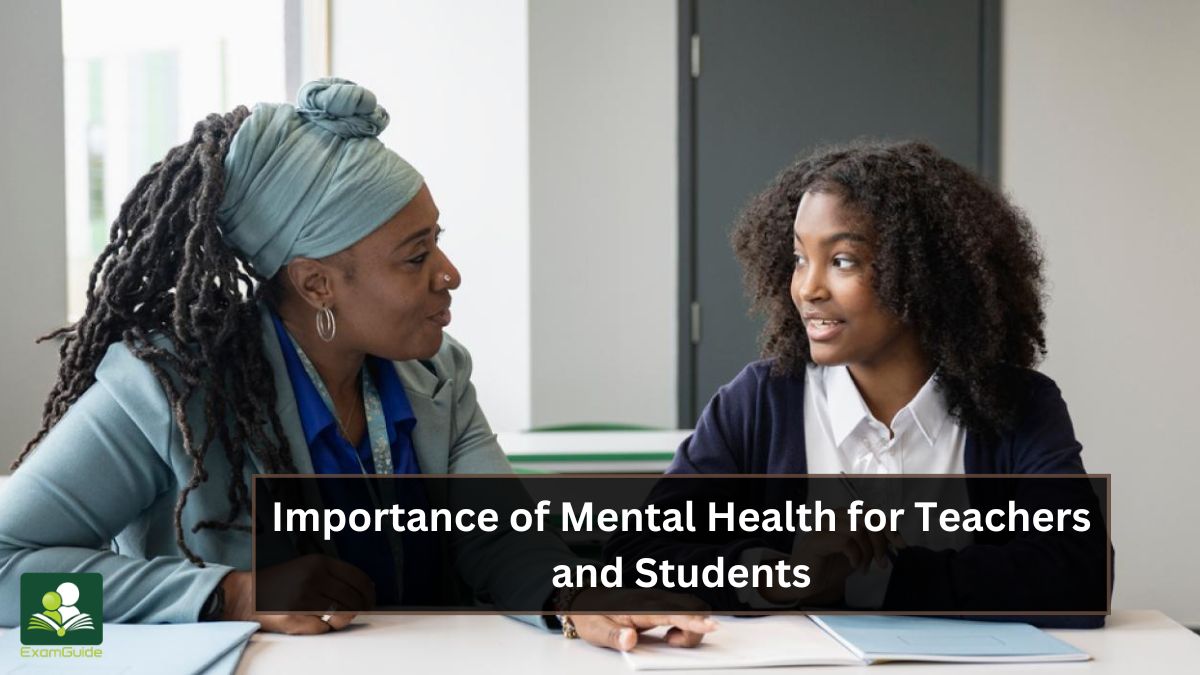
Importance of Mental Health for Teachers and Students
Mental health is a crucial aspect of overall well-being, influencing how individuals think, feel, and act. In the educational environment, the mental health of teachers and students plays a significant role in the effectiveness of the teaching-learning process.
This article explores the importance of mental health for teachers and students, their challenges, and strategies to promote mental well-being in schools.
Table of Content
Why is Mental Health Important for Teachers?
Importance of Mental Health for Students
Challenges to Mental Health in Schools
Strategies to Promote Mental Health in Schools
What Role Do Mental Health Professionals Play in Schools?
What are Some Effective Mental Health Programs that Schools can Implement?
What is Mental Health?
Mental health refers to a state of well-being in which an individual realises their abilities, can cope with the normal stresses of life, work productively, and contribute to their community. It encompasses emotional, psychological, and social well-being, affecting how people think, feel, and act.
Key Components of Mental Health
- Emotional Well-being
- Positive Emotions: Experiencing happiness, love, and satisfaction.
- Emotional Regulation: The ability to manage and respond to emotions in a healthy way.
- Psychological Well-being
- Self-acceptance: Having a positive view of oneself and one's past.
- Personal Growth: The ongoing process of developing and improving oneself.
- Purpose in Life: Having goals and a sense of direction in life.
- Environmental Mastery: The ability to manage life situations effectively.
- Autonomy: Having a sense of independence and control over one’s actions.
- Positive Relationships: Forming healthy, satisfying relationships with others.
- Social Well-being
- Social Contribution: Feeling that one’s activities are useful to society.
- Social Integration: Feeling a sense of belonging to a community.
- Social Acceptance: Having positive attitudes towards others.
- Social Actualization: Believing that society and social institutions are evolving positively.
Importance of Mental Health
1. Impact on Physical Health
Mental health and physical health are closely connected. Poor mental health can increase the risk of physical illnesses, such as heart disease, diabetes, and chronic pain, and vice versa. Maintaining good mental health can promote better physical health and overall well-being.
2. Daily Functioning
Good mental health allows individuals to perform daily activities effectively, manage stress, and make rational decisions. It enhances productivity and performance in work, school, and other areas of life.
3. Quality of Life
Mental health significantly affects the quality of life. It influences how individuals feel about themselves, their relationships, and their capacity to enjoy life. Positive mental health leads to higher life satisfaction and happiness.
4. Relationships
Mental health plays a crucial role in forming and maintaining healthy relationships. It affects communication, empathy, and the ability to build and sustain connections with others.
5. Resilience
Good mental health equips individuals with the resilience to cope with life’s challenges and setbacks. It helps in bouncing back from adversity, managing stress, and maintaining a positive outlook even in difficult times.
Why is Mental Health Important for Teachers?
1. Enhancing Teaching Effectiveness
Teachers with good mental health are more engaged, enthusiastic, and creative in their teaching methods. They can plan lessons more effectively, manage classrooms better, and provide high-quality education. Mental well-being allows teachers to bring their best selves to the classroom, promoting a positive and exciting learning environment.
2. Preventing Burnout
Teaching is a demanding profession that often leads to stress and burnout due to heavy workloads, administrative duties, and the emotional demands of supporting students. Maintaining good mental health helps prevent burnout by enabling teachers to manage stress, maintain energy levels, and stay motivated.
This, in turn, ensures that they remain effective and passionate about their work.
3. Positive Teacher-Student Relationships
Mentally healthy teachers are better equipped to build strong, supportive relationships with their students. These relationships are foundational for student engagement and success. When teachers are emotionally stable, they can provide the necessary support, understanding, and empathy that students need to thrive academically and personally.
Positive relationships also create a more trusting and respectful classroom environment.
4. Role Modeling
Teachers serve as role models for their students. By prioritizing their mental health, teachers can demonstrate the importance of self-care and emotional well-being. This modelling can encourage students to adopt similar practices, leading to a healthier school community.
When students see their teachers managing stress effectively and practising self-care, they are more likely to emulate these behaviours.
5. Creating a Positive Learning Environment
Good mental health allows teachers to maintain a positive and calm demeanour, which significantly impacts the classroom atmosphere. A teacher’s mood and behaviour can set the tone for the entire class.
When teachers are mentally well, they are more patient, understanding, and able to create an environment conducive to learning and growth.
6. Improving Professional Relationships
Mental health is essential for promoting positive relationships with colleagues, administrators, and parents. Teachers who maintain good mental health are better communicators, more collaborative, and able to navigate conflicts and challenges effectively. This leads to a more supportive and cohesive educational community.
7. Enhancing Personal Well-being
Beyond their professional roles, teachers are individuals with personal lives and responsibilities. Good mental health is crucial for their overall well-being, helping them to enjoy a balanced and fulfilling life outside of work.
This balance is important for sustaining long-term health and happiness, preventing professional stress from negatively impacting their personal lives.
Importance of Mental Health for Students
1. Academic Performance
Mental health significantly impacts students' ability to learn and perform academically. Students who experience anxiety, depression, or other mental health issues often struggle to concentrate, complete assignments, and engage in class. Addressing mental health needs can lead to improved academic outcomes.
2. Social and Emotional Development
Good mental health is essential for the social and emotional development of students. It enables them to build healthy relationships, develop empathy, and handle social challenges effectively. Emotional well-being is foundational for students to navigate the complexities of school life and beyond.
3. Reducing Behavioral Issues
Mental health issues can manifest as behavioural problems in the classroom. Students struggling with untreated mental health conditions may exhibit aggression, withdrawal, or other disruptive behaviours. Supporting mental health can reduce these issues, creating a more conducive learning environment for all.
4. Long-term Well-being
Addressing mental health in students sets the foundation for long-term well-being. Early intervention and support can help students develop coping mechanisms, resilience, and a positive outlook on life. These skills are invaluable as they transition into adulthood and face new challenges.
Challenges to Mental Health in Schools
1. Stigma
There is often a stigma associated with mental health issues, which can prevent teachers and students from seeking help. This stigma needs to be addressed through awareness campaigns and education to create a more accepting and supportive environment.
2. Lack of Resources
Many schools lack the resources necessary to support mental health adequately. This includes access to counsellors, psychologists, and mental health programs. Ensuring that schools are well-equipped with these resources is crucial for promoting mental well-being.
3. High Stress Levels
Both teachers and students face high levels of stress. Teachers may deal with heavy workloads, administrative pressures, and diverse classroom challenges, while students contend with academic demands, social pressures, and personal issues. Effective stress management strategies are essential for maintaining mental health.
4. Insufficient Training
Teachers often lack training in identifying and supporting mental health issues. Professional development programs that focus on mental health awareness and intervention strategies can empower teachers to better support their students and themselves.
Strategies to Promote Mental Health in Schools
1. Creating a Supportive Environment
Schools should promote a supportive and inclusive environment where mental health is prioritized. This can be achieved by promoting open discussions about mental health, encouraging empathy and respect, and creating safe spaces for students and teachers to express their feelings.
2. Providing Access to Mental Health Resources
Schools need to ensure access to mental health professionals such as counsellors and psychologists. Regular mental health screenings and interventions can help identify and address issues early.
Additionally, providing resources like stress-relief workshops, mindfulness programs, and mental health education can be beneficial.
3. Implementing Mental Health Programs
Structured mental health programs that focus on resilience, stress management, and emotional intelligence can be integrated into the curriculum. These programs can equip students and teachers with the skills needed to manage their mental health effectively.
4. Encouraging Self-Care
Promoting self-care practices among teachers and students is essential. This includes encouraging regular physical activity, healthy eating, adequate sleep, and relaxation techniques. Schools can organize wellness activities and provide resources that support self-care.
5. Professional Development for Teachers
Providing teachers with professional development opportunities focused on mental health awareness and support strategies is crucial. Training can help teachers recognize signs of mental health issues, implement supportive classroom practices, and manage their own stress effectively.
6. Parental and Community Involvement
Engaging parents and the community in mental health initiatives can create a more comprehensive support system. Schools can organize workshops, seminars, and informational sessions to educate parents about mental health and involve them in creating a supportive environment.
What Role Do Mental Health Professionals Play in Schools?
Mental health professionals play a critical role in schools by supporting the emotional and psychological well-being of students and staff. Their contributions are essential in creating a healthy school environment that promotes learning, personal growth, and overall well-being.
Here are some of the key roles and responsibilities they fulfil:
1. Counseling and Support Services
- Individual Counseling: Mental health professionals provide one-on-one counseling sessions to help students deal with personal issues, anxiety, depression, family problems, and other mental health concerns.
- Group Counseling: Facilitating group sessions for students dealing with similar issues, such as grief, stress, or social skills, helps build peer support and shared understanding.
- Crisis Intervention: In emergencies, mental health professionals offer immediate support and intervention to students and staff experiencing acute mental health crises.
2. Mental Health Assessments
- Screenings and Evaluations: Conducting mental health screenings and psychological assessments to identify students in need of further support or intervention.
- Behavioural Assessments: Evaluating behavioural issues to develop appropriate intervention strategies and support plans for students.
3. Creating Supportive Environments
- Safe Spaces: Establishing safe and confidential environments where students can express their feelings and concerns without fear of judgment.
- Well-being Programs: Implementing programs and activities that promote mental well-being, such as mindfulness sessions, stress management workshops, and relaxation techniques.
4. Collaboration with Educators and Staff
- Teacher Support: Providing training and resources to teachers on recognizing and responding to signs of mental health issues in students.
- Consultation: Working with teachers and school staff to develop and implement classroom strategies that support students’ mental health and learning needs.
- Professional Development: Offering workshops and training sessions to educate school staff about mental health awareness and effective intervention strategies.
5. Family and Community Engagement
- Parental Involvement: Engaging parents and guardians in the mental health care of their children by providing guidance, resources, and support.
- Community Resources: Connecting families with external mental health resources and services, such as therapists, social workers, and community programs.
- Workshops and Seminars: Organizing educational sessions for parents and the community to raise awareness about mental health issues and available support systems.
6. Developing and Implementing Policies
- School Policies: Assisting in the creation and enforcement of school policies that promote a safe and supportive environment for mental health, such as anti-bullying policies and protocols for addressing mental health crises.
- Advocacy: Advocating for the mental health needs of students and staff at the school and district levels to ensure adequate resources and support systems are in place.
7. Promoting Mental Health Awareness
- Education Campaigns: Running awareness campaigns to educate students, staff, and the wider school community about mental health issues, stigma reduction, and the importance of seeking help.
- Resource Distribution: Providing educational materials and resources on mental health topics to students, teachers, and parents.
8. Monitoring and Evaluation
- Tracking Progress: Monitoring the progress of students receiving mental health support to evaluate the effectiveness of interventions and make necessary adjustments.
- Outcome Measurement: Collecting and analyzing data to assess the impact of mental health programs and initiatives within the school.
What are Some Effective Mental Health Programs that Schools can Implement?
In Nigeria, addressing mental health in schools is essential to support the well-being of students and staff, given the country's unique social and economic challenges.
Here are some effective mental health programs and initiatives that can be implemented or have been successfully implemented in Nigerian schools:
1. Mindfulness and Stress Management Programs
- Description: These programs teach students and teachers mindfulness techniques and stress management skills to help them cope with daily challenges.
- Example: Initiatives like the Mindfulness for Adolescents Project, which teaches mindfulness practices to help students manage stress and improve focus.
2. School-Based Counseling Services
- Description: Providing in-school counselling services to offer direct mental health support to students dealing with various emotional and psychological issues.
- Example: Schools can partner with local NGOs and mental health professionals to offer regular counselling sessions, such as through the services provided by organizations like Mentally Aware Nigeria Initiative (MANI).
3. Mental Health Awareness and Education Campaigns
- Description: These campaigns aim to raise awareness about mental health issues, reduce stigma, and encourage students and staff to seek help when needed.
- Example: The “Mental Health Awareness in Schools” campaign by MANI focuses on educating students about mental health, recognizing signs of mental health issues, and promoting a supportive environment.
4. Anti-Bullying Programs
- Description: Implementing programs to prevent and address bullying, thereby creating a safer and more inclusive school environment.
- Example: Initiatives such as the Safe Schools Initiative, which aims to create a safe learning environment free from bullying and violence.
5. Peer Support and Mentorship Programs
- Description: Training students to provide emotional and social support to their peers, fostering a supportive and understanding school community.
- Example: Programs like Peer Educator Training, where selected students are trained to provide peer support and mentorship, helping to identify and support classmates facing mental health challenges.
6. Parent and Community Involvement Programs
- Description: Engaging parents and the community in mental health initiatives to create a holistic support system for students.
- Example: Workshops and seminars organized by school PTAs (Parent-Teacher Associations) to educate parents about mental health and how they can support their children.
7. Life Skills and Resilience Building Programs
- Description: Teaching students essential life skills and resilience techniques to help them cope with life’s challenges and build mental toughness.
- Example: Programs like the Life Skills Education Program by UNICEF, which equips students with skills such as critical thinking, problem-solving, and emotional regulation.
8. Collaborations with Local NGOs and Health Agencies
- Description: Partnering with local NGOs and health agencies to provide comprehensive mental health services and support.
- Example: Collaborations with organizations like MANI, She Writes Woman, and Neem Foundation to bring mental health education, counselling, and support services to schools.
9. Integration of Mental Health into the Curriculum
- Description: Incorporating mental health education into the school curriculum to ensure students receive continuous and structured learning about mental health.
- Example: Developing modules on mental health awareness, emotional intelligence, and stress management to be taught as part of health education classes.
10. Professional Development for Teachers
- Description: Providing ongoing training for teachers on mental health awareness, identifying at-risk students, and offering initial support.
- Example: Training programs conducted by mental health organizations or local health departments to equip teachers with the necessary skills to support students effectively.
Conclusion
Mental health is a critical component of the educational experience for both teachers and students. Ensuring mental well-being leads to more effective teaching, better academic performance, and a healthier school community.
By addressing the challenges and implementing strategies to promote mental health, schools can create an environment where everyone can thrive. Prioritizing mental health is not just beneficial but essential for the development and success of teachers and students alike.
No comment found
Related Posts

Top 20 Motivational Quotes for Students to Work Hard

How to Use Past Questions for Effective WAEC and JAMB Preparation

Language barriers in Nigerian Education and how to Overcome them

How to Excel in Mathematics: Tips for Nigerian Students

How to Summarize Notes Effectively for Faster Revision


